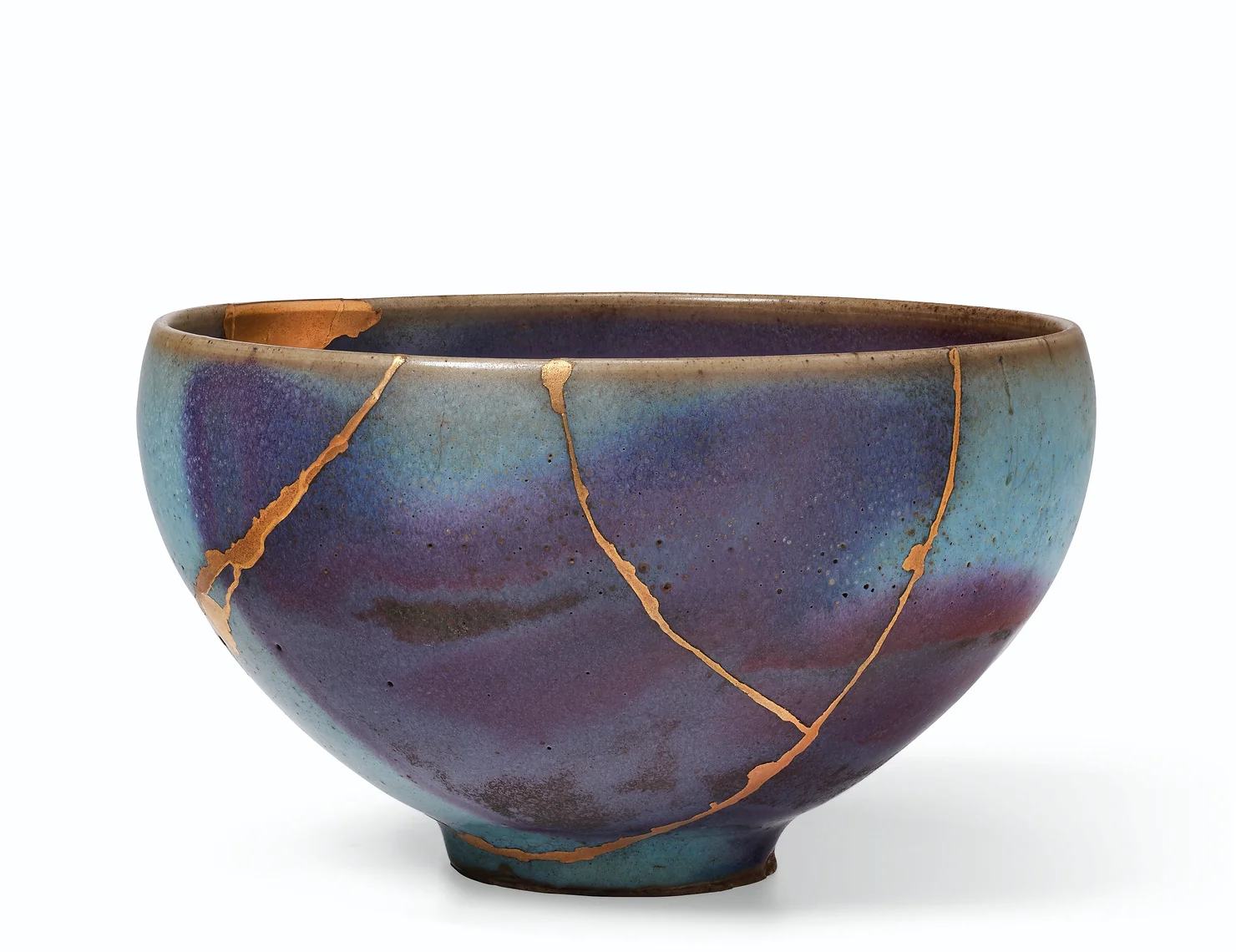宋代筆記 vol.54 金繕宋代鈞窯泡泡碗 75萬港幣再現香江收藏 - Song Notes: Kintsugi Jun Bubble Bowl reappears in Hong Kong.
- SACA
- May 5, 2024
- 4 min read
宋磁,以承上啟下的姿態,多元包容的窯口和裝飾藝術聞名,並成為世界一流的收藏品。在20世紀初期,歐美各地開始意識到學習亞洲文化的重要性,紛紛開設了博物館東方部,著名的波士頓美術館、大都會博物館都是在1915-1916左右成立東方部,當時任命的還是著名的岡倉天心作為亞洲部主任。
宋磁的魅力在於其包容性,更是因為其有一定的存世量。然而,在存世量中挑選出佼佼者,所謂的「級別高」的器物,成為了收藏家的一種樂趣。這種甄選,財力只是入門券,眼力的鍛鍊,性格的磨練,抉擇的進階,才是真正的關鍵。宋磁的收藏,從根本意義上是一種自我的修行。
本文介紹的泡泡碗,國外稱「bubble bowl」便是鈞窯器物中的佼佼者。這類器物,曾經創造出將近3000萬港元的高價,如今一個好質量的泡泡碗,哪怕是『金繕』過,也依然瑕不掩瑜。這種寧可玉碎,不要瓦全的精神,可以說是藏家對自我提升,精神訴求的一種決絕。
左:本品 - 750,000 HKD 蘇富比2017年 人間異珍︰奇•趣 / 拍品 3055; 右:北宋 鈞窯紫斑盌 紐約蘇富比 2020年7月24日 成交價 USD 187,500
而本文介紹的這件也是傳承顯赫,來自平野古陶軒、Eskenazi等著名經銷商。從這兩件器物可以看到,對這類器物的認可,從一個世紀前就開始,國際市場對這類器物的價值認定非常堅固,品相的問題,並不會打消頂級收藏家購藏的熱情。
值得注意的是,蘇富比亞洲區主席Nicolas Chow仇國仕似乎正是這件器物的藏家。在其近期發布的社交媒體上,這件器物被擺放在斑駁的桌面上,頗有侘寂的意味。
金 鈞窰天藍釉紫斑盌
估價 600,000 - 800,000 HKD
已售出 750,000 HKD
蘇富比2017年 人間異珍︰奇•趣 / 拍品 3055
with steep rounded sides rising from to a short neat knife-cut foot to a gently incurved rim, applied overall save for the foot with a lustrous pale milky-blue glaze draining to a mushroom tone at the rim and pooling short of the foot, the exterior and interior liberally decorated with vibrant lavender-blue splashes, later applied with Japanese kintsugi restoration
來源
平野古陶軒,東京
Sadao Ogawa,東京
紐約蘇富比2010年9月15日,編號308
埃斯卡納齊古董行,倫敦
Provenance
Hirano Kotoken, Tokyo.
Sadao Ogawa, Tokyo.
Sotheby's New York, 15th September 2010, lot 308.
Eskenazi Ltd, London.
展覽
《Junyao》,埃斯卡納齊古董行,倫敦,2013年,編號8
Condition
This charming bubble bowl is well potted with a pleasant shape and attractive glaze. As visible in the catalogue illustration, the bowl has Japanese gold lacquer restoration, which appear to originate from a semi-circular break on the rim approximately 1 1/4 inch wide and includes two restored cracks, one running across the foot and the other along one side. The glaze with fine surface wear.
拍品資料及來源
「鈞瓷無雙」,鈞瓷之名貴在於「入窰一色出窰萬彩」之獨特窰變釉色,非人工能描繪。此器釉色瑩潤,月白地如高山雲霧,內外紫斑如點點紅霞,難怪古人以「 雨過天晴泛紅霞,夕陽紫翠忽成嵐」形容鈞瓷之特色。
此器與 David Home 所藏一例甚為相似,曾展於東方陶瓷學會,見《Sung Dynasty Wares, Chun and Brown Glazes》,倫敦,1952年,編號157,後售於香港蘇富比1987年11月24日,編號 5。仇焱之舊藏兩件釉色同樣豐富,售於倫敦蘇富比1980年12月16日,編號264及265,其後為徐展堂所藏,售於倫敦蘇富比2000年6月7日,編號93。Eumorfopoulos 藏相似例,載於 R.L. Hobson,《The Catalogue of the George Eumorfopoulos Collection of Chinese, Corean and Persian Pottery and Porcelain》,卷2,圖版A31及 A32。一例原為 Schoenlicht 舊藏,後入松岡收藏,錄於《松岡美術館收藏中國陶磁名品展》,東京,1983年,編號36,售倫敦蘇富比1955年12月13日,編號76,其後再轉 H.M. Knight 收藏,售於香港蘇富比1982年5月18日,編號109。
柯玫瑰於書中記,鈞瓷紫斑器,取銅料,着筆幾抹入窰,火去時,青紫交融,現斑斕,五光十色,每窰絕無同者,見《Song Dynasty Ceramics》,倫敦,2004年,頁34。
Among the genre of Song dynasty ceramics, Junyao bubble bowls are perhaps the most tactile and personal of items, as the small rounded sides and unctuous glaze allow the bowls to conform perfectly to the hands.
It is rare to find a Junyao bubble bowl with this striking combination of intense and rich splashes on the interior and the unusual arrangement of smaller splashes on the exterior, reminiscent of the bowl from the collection of Sir David Home, Bt., exhibited at the Oriental Ceramics Society exhibition of Sung Dynasty Wares, Chun and Brown Glazes, London, 1952, cat. no. 157 and sold in these rooms, 24th November 1987, lot 5. For intensity of colouration, compare the two extraordinary bowls from the Edward T. Chow Collection sold in our London rooms, 16th December 1980, lots 264 and 265, and again in these rooms, the former on 19th May 1987, lot 209, and later in the T.T. Tsui Collection, the latter on 7th June 2000, lot 93. Similar bowls are in the Eumorfopoulos Collection, illustrated in R.L. Hobson, The Catalogue of the George Eumorfopoulos Collection of Chinese, Corean and Persian Pottery and Porcelain, vol. 2, pls A31 and A32; and in the Matsuoka Collection, included in Matsuoka Bijutsukan shūzō Chūgoku tōji meihin ten[Masterpieces of Chinese ceramics from the Matsuoka Museum of Art], Tokyo, 1983, pl. 36, formerly in the Schoenlicht Collection, sold in our London rooms, 13th December 1955, lot 76, and in the H.M. Knight Collection, and sold again in these rooms, 18th May 1982, lot 109.
According to Rose Kerr, Song Dynasty Ceramics, London, 2004, p. 34, the splashes found on Jun wares are made with the application of copper brushwork to dry glazes in broad strokes or washes, which then merged with the bluish Junyao glazes at full heat. This copper painting provided a striking contrast to the thick bright blue glaze beneath giving each vessel decorated in this manner its unique design.

















Comments